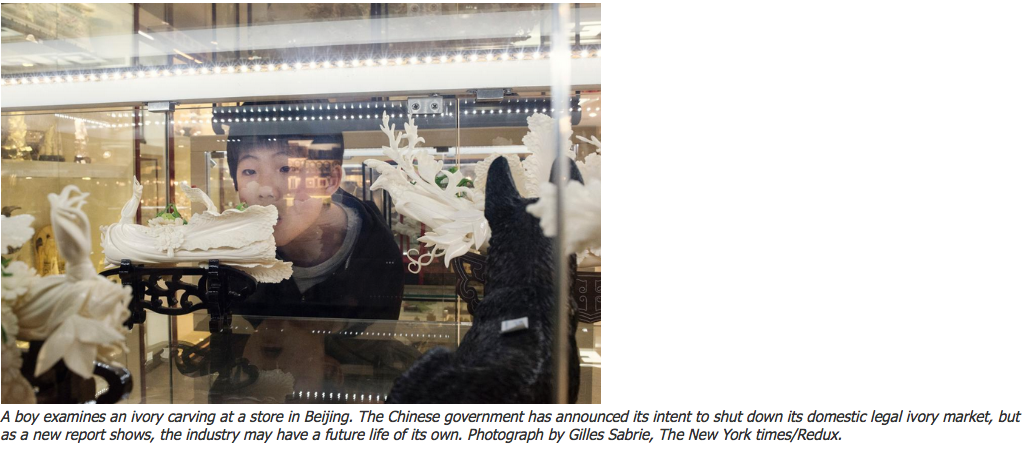National Geographic: Why Shutting Down China’s Ivory Trade Won’t Be Easy
An undercover investigation shows how Chinese businesses launder illegal ivory into the legal market and also trade in illegal rhino horn.
PUBLISHED

China is the world’s largest ivory consumer, with its legal market often providing cover for illegal ivory. The intertwining of these two markets—legal and illegal—is the subject of a new report by Elephant Action League, a nonprofit organization dedicated to fighting wildlife crime.
The country has a legal ivory stockpile of about 40 metric tons that, based on annual drawdowns by government-licensed businesses, has a lifespan of likely under eight years. Illegal stocks are reportedly 25 times greater.
The report, Blending Ivory: China’s Old Loopholes, New Hopes, details a ten-month undercover investigation that exposes multiple mechanisms used by legal businesses to launder illegal ivory into China’s legal market.
It presents seven insights that illustrate the challenges of shutting down the market while at the same time raising hopes for success.
-- Astute companies in the legal ivory business have figured out how to use proxies to circumvent the law. For example, Beijing Mammoth Art Co., Ltd. established a subsidiary company, Tung’s Carving Gallery, in Hong Kong to import the ivory, work it, and re-export it to the parent company in Beijing. This prevents Beijing Mammoth from having to deplete its own stocks of raw tusks, and it legitimizes the worked ivory through Hong Kong’s licensing system. (The Hong Kong government issues licenses to vendors, who are supposed to report the total weight of ivory in their possession. But recent studies indicate that many vendors likely replenish stocks with illegal ivory.)
“Through this transaction process, everything is legal,” the head of Beijing Mammoth—referred to in the report as Beijing Trader 2—told investigators. (While the report authors omitted the names of individual targets, they’ve submitted this information to Chinese and Hong Kong authorities.)
-- China’s ivory businesses are deeply involved in Africa. The holdings of Beijing Mammoth, for example, include African safari companies, taxidermists, and traders of live animals. “We helped Guangzhou Zoo import about 20 live elephants,” Beijing Trader 2 said.
-- Trophy hunting is a legal “grey” area exploited by traders. Beijing Mammoth runs hunting safari operations in Zimbabwe and South Africa through a holding company, Beijing Tian Hao Bo Rui International Sports Exchange Ltd. From there, it can import ivory and trophies.
“You can go trophy hunting with us and take the ivory,” Beijing Trader 2 said. Three storage rooms in Beijing Mammoth’s warehouse contained large and small tusks that were labeled “from hunting,” “from Europe,” “from Africa,” and “from Mombasa.”
-- Importing full trophy mounts is a way to avoid regulations. Beijing Mammoth imports rhino trophies from an affiliate in South Africa. Beijing Trader 2 described how rhino trophies are prepared by a taxidermist, shipped back to China, and then, he said, “I would place fake horns on it.” This way, the real rhino horns can be used or sold, while the full mount is available for inspections.
-- Trade in rhino horn, which is easier to smuggle than elephant tusks, is conspicuous and overlaps with the ivory trade. During the investigation, at least half the investigators’ targets offered them rhino horn items such as bracelets, cups, or powders. Rhino horn often came up in conversation, according to Andrea Crosta, founder of the Elephant Action League and coauthor of the report. “For me it was surprise,” he said. “We weren’t even looking for rhino horn. One guy said he could sell as much rhino horn as he could get. It’s a thriving market.”
-- The ivory industry, with affiliated companies at all levels of the supply chain, has a life of its own. Even if retail markets and profit margins decline, the vertically integrated industry is structured to persist, with ivory outlets shifting from retail stores directly to the consumer. “It’s a dangerous situation,” Crosta notes. “Even if consumers are buying less, from a business perspective the machine is still working.”
-- Ivory companies are considering options to get out of the trade. Some of the biggest ivory traders met in November to discuss their future. This indicates that from an economic perspective they understand that it’s getting more difficult to be in the ivory business.
While that’s a positive development, others are betting on a rosy future for ivory. The investigation found that investors and traders have stockpiled 1,000 metric tons of illegal ivory in secret locations. The government will have to figure out how to remove all this if an ivory ban is to be feasible.
